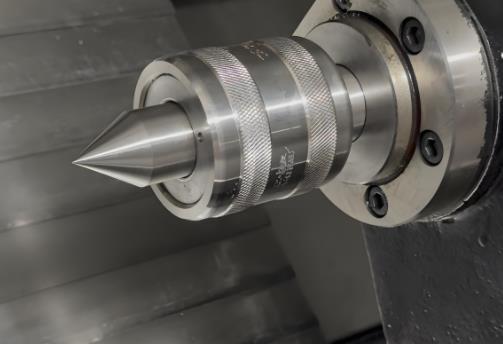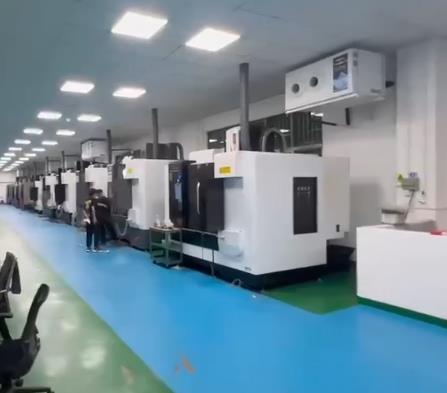To understand the technicality of CNC lathe machining, let’s break down its core components and workflow:
1. Core Components of a CNC Lathe
- Spindle: Holds and rotates the workpiece at adjustable speeds (100–6,000 RPM, depending on the machine). High-end CNC lathes use precision spindle bearings to minimize vibration, critical for tight tolerances.
- Tool Turret: A rotating holder that stores multiple cutting tools (e.g., turning tools, drilling tools, threading tools). The turret swaps tools automatically mid-program, enabling multi-operation machining in one setup.
- CNC Control Panel: Runs the G-code program, allowing operators to load files, adjust parameters (speed, feed rate), and monitor the process in real time. Popular control systems include Fanuc, Siemens, and Haas.
- Feed Mechanism: Driven by servo motors, it moves the tool turret along the X and Z axes with micron-level precision. Servo motors ensure smooth, responsive movement—critical for avoiding tool chatter (vibration that ruins surface finish).
- Coolant System: Sprays cutting fluid to reduce heat (from friction) and lubricate the tool-workpiece interface, extending tool life and preventing workpiece warping.
2. Typical Workflow of CNC Lathe Machining
- Design & Programming: Use CAD (Computer-Aided Design) software (e.g., SolidWorks, AutoCAD) to create a 3D model of the part. Convert the model to G-code via CAM (Computer-Aided Manufacturing) software (e.g., Mastercam, Fusion 360), which optimizes tool paths for efficiency.
- Workpiece Setup: Clamp the raw material (e.g., metal bar, plastic rod) into the spindle using a chuck or collet. Ensure alignment to avoid runout (uneven rotation).
- Tool Calibration: Use a tool setter to measure tool length and diameter, inputting these values into the CNC control to ensure accurate cuts.
- Run the Program: Start the program, and the CNC lathe automates the process—rotating the workpiece, moving the cutting tool, and swapping tools as needed.
- Quality Inspection: After machining, check the part’s dimensions with precision tools (e.g., calipers, micrometers, CMMs [Coordinate Measuring Machines]) to verify compliance with specs.

Core Advantages of CNC Lathe Machining
Why has CNC lathe machining become the go-to for precision manufacturing? Its benefits address key pain points of traditional methods:
- Unmatched Precision & Consistency: CNC lathes achieve tolerances as tight as ±0.001mm, making them ideal for parts where even minor deviations cause failure (e.g., medical implants, aerospace components). Because the program controls every movement, every part in a batch is identical—no more “operator-dependent” quality.
- Higher Efficiency & Reduced Labor Costs: A single CNC lathe can run 24/7 with minimal supervision (after setup), unlike manual lathes that require constant operator attention. This reduces labor costs and increases throughput: a CNC lathe can produce 5–10x more parts per hour than a manual machine for complex jobs.
- Flexibility for Complex Designs: With multi-axis CNC lathes (e.g., 3-axis, 4-axis), manufacturers can produce parts with intricate features: internal/external threads, tapers, contours, and even 3D shapes. Changing between part designs only requires updating the G-code—no need to reconfigure the entire machine (unlike traditional lathes).
- Extended Tool Life & Material Savings: CNC systems optimize feed rates and spindle speeds for the material (e.g., aluminum, steel, titanium) and tool type, reducing tool wear. Additionally, precise tool paths minimize material waste—critical for expensive materials like titanium or medical-grade stainless steel.
Key Applications of CNC Lathe Machining
CNC lathe machining is used across nearly every industry that requires precision cylindrical parts. Here are its most common use cases:
- Automotive Industry: Produces engine components (crankshafts, camshafts, piston pins), transmission parts (gears, shafts), and brake system components. CNC lathes ensure these parts withstand high stress and meet strict safety standards.
- Aerospace & Defense: Manufactures critical parts like aircraft engine shafts, missile components, and satellite brackets. These parts often use high-strength materials (titanium, Inconel) and require tolerances of ±0.002mm—something only CNC lathes can deliver.
- Medical Device Manufacturing: Creates implants (hip stems, dental abutments), surgical tools (scalpels, drill bits), and diagnostic equipment parts. CNC lathes handle biocompatible materials (titanium alloy, PEEK plastic) with the precision needed to avoid patient harm.
- Electronics & Consumer Goods: Makes connector pins, sensor housings, and small components for smartphones, laptops, and appliances. The high speed of CNC lathes ensures mass production meets consumer demand.
Frequently Asked Questions (FAQ) About CNC Lathe Machining
Q1: What materials can be machined with a CNC lathe?
CNC lathes handle most solid materials, including:
- Metals: Aluminum, steel, stainless steel, titanium, brass, copper.
- Plastics: PEEK, ABS, nylon, acrylic.
- Composites: Carbon fiber-reinforced polymers (CFRP).
The only limitation is material hardness—extremely hard materials (e.g., tungsten carbide) may require specialized tools (e.g., ceramic cutters).
Q2: How long does it take to program a CNC lathe?
Programming time depends on part complexity:
- Simple parts (e.g., a cylindrical rod with a hole): 30 minutes to 1 hour (using CAM software).
- Complex parts (e.g., a threaded aerospace shaft): 2–4 hours (plus testing to optimize tool paths).
For repeat orders, the program is saved and reused—no need to reprogram.
Q3: Is CNC lathe machining suitable for small-batch production?
Yes! Unlike traditional mass-production methods, CNC lathes have low setup costs for small batches (1–100 parts). The flexibility to switch between designs quickly makes them ideal for prototyping, custom parts, and low-volume orders.
Q4: How do I maintain a CNC lathe to ensure precision?
Key maintenance steps include:
- Daily: Clean the spindle, tool turret, and coolant tank; check coolant levels.
- Weekly: Lubricate guideways and ball screws; inspect tool wear.
- Monthly: Calibrate axes using a laser interferometer; test spindle runout.
Proper maintenance ensures the machine retains its precision for 10–15 years.
Our CNC Lathe Machining Services at Rapid Model
At Rapid Model, we leverage state-of-the-art CNC lathe machining technology to deliver high-precision parts for industries ranging from automotive to medical. Our services are designed to solve your manufacturing challenges—whether you need a single prototype or large-batch production.
What Sets Our CNC Lathe Machining Apart?
- High-Precision Equipment: We use advanced CNC lathes with 4-axis capabilities, achieving tolerances as tight as ±0.01mm.
- Experienced Engineering Team: Our CAM programmers and machinists have 10+ years of experience optimizing tool paths for complex parts—reducing lead times and material waste.
- Material Versatility: We machine all common metals, plastics, and composites, including biocompatible and high-temperature materials (e.g., Inconel, PEEK).
- End-to-End Quality Control: Every part undergoes inspection with CMMs and precision gauges to ensure compliance with your specs.
- Fast Turnaround: For prototypes, we offer 1–3 day delivery; for large batches, we scale production to meet your timeline.
Whether you need custom threaded shafts, medical implants, or automotive components, Rapid Model’s CNC lathe machining services deliver reliability, precision, and value. Contact us today to share your part design—our team will provide a free quote and technical consultation to bring your project to life.



